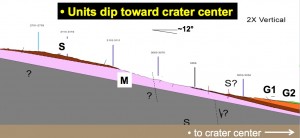
DOWNWARD TREND. An east-west profile across rim segments on the western side of Endeavour Crater shows the rocks slope down into the crater center. The letter S indicates the Shoemaker Formation, which is an impact-made breccia, while M denotes the Matijevic Formation, the Noachian-age surface rocks before the impact. (Image taken from Figure 3 in the abstract.)
The Mars Exploration Rover Opportunity, exploring the eroded rim segments of Endeavour Crater, has found that the uplifted rocks of the crater’s rim have an unexpected structure: they slope downward into the crater. Geologist Larry Crumpler (New Mexico Museum of Natural History & Science) reported (PDF) on studies by Opportunity at rim segments Cape York, Botany Bay, and Solander Point at the 45th Lunar and Planetary Science Conference in The Woodlands, Texas.
Since the rover first arrived at Cape York almost 1,000 sols ago, Crumpler says, it has mapped the contact between the Shoemaker Formation and the underlying Matijevic Formation. The Shoemaker rocks are breccias taken to be the shattered and ejected debris from the impact, while the underlying Matijevic rocks represent the pre-impact surface.
“The results indicate that the dip of the Shoemaker Formation impactite section, and the unconformity with the pre-impact surface, dip approximately 11° degrees east, towards the crater center,” he says. Scientists have never examined a Martian crater of this size first hand, he explains, so expectations were more that rim rocks would be flat-lying or outward sloping. As to how the inward dip happened, Crumpler suggests that in the impact, the pre-existing target rocks that lay at the distance of the rim may have been thrust upward and outward by the blast, instead of being simply lifted and flipped over.
Endeavour Crater, 22 km (14 miles) wide, is a much-eroded example of a type scientists call a complex crater. To show an example of what Endeavour may have looked like when fresher, Crumpler points to Santa Fe Crater, which lies in Chryse Planitia and is a billion years or more younger. It shows central peaks, slumped terraces on its interior walls, and a somewhat irregular rim outline — all features that have vanished from Endeavour, except for a slightly meandering outline of its rim remnants.








